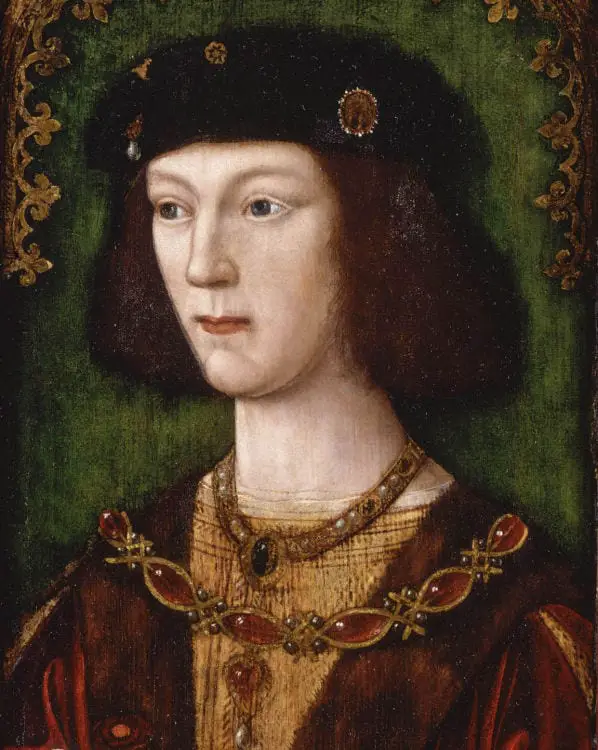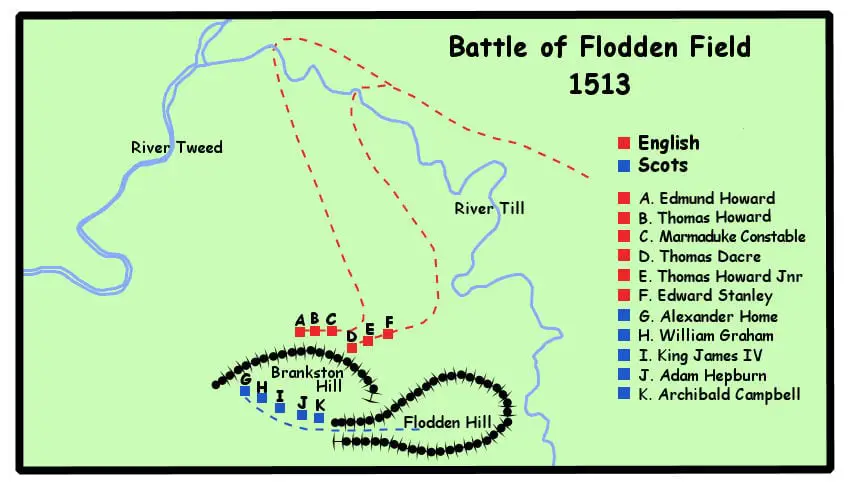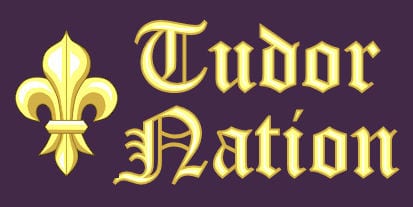Background to the Battle of Flodden Field – The War with France
Henry VIII had become King of England in 1509 following the death of King Henry VII. He dreamed of following in the footsteps of King Henry V and taking control of France. In 1511 he began a war with France. Henry’s father-in-law, Ferdinand of Aragon encouraged Henry in this pursuit. Ferdinand knew that if Henry were to defeat France it would rid Spain of its enemy with no loss of money or men.

Henry declared war on France in April 1512. Initially the action was confined to naval attacks while the English army was mustered.
English troops began being transported to Calais in May 1513. The Earl of Surrey, who was not going to France, was sent north to be ready for any attack by the Scots.
On the 15th June King Henry VIII travelled to Dover at the head of an army of 11,000 men to make the crossing to Calais. At Dover castle, Catherine of Aragon was formally invested with the regency of the country. Her advisors were to be William Warham, Archbishop of Canterbury, Thomas Ruthall and Richard Foxe.
The Scottish Invasion of England

The Auld Alliance, first made in 1295, was a treaty of mutual assistance between Scotland and France against England. In the Summer of 1513, after the English invasion of France, King Louis XII sent a message asking James IV to invade England in support of France.
The Scottish King had agreed a peace with England in 1503 and was married to Henry’s sister, Margaret. Nevertheless, he duly sent a warning to Henry that if he continued to act in an aggressive manner towards France then Scotland would invade England.
By mid-August, James had heard nothing from the English King and so invaded England with a Scottish force.
When news reached Catherine of Aragon that the Scots had invaded, she ordered Thomas Howard, Earl of Surrey, to muster troops and deal with the invasion. She also travelled north herself to rally the troops and also to be on hand if quick decisions needed to be taken.
The Scottish army were camped in a strong defensive position on Flodden Hill. Catherine of Aragon ordered Thomas Howard to attack the Scottish army, but before doing so he wanted to entice the Scots off Flodden Hill. He decided to make a long advance towards the Scots’ position and crossed the River Till some distance north of Flodden Hill. It is likely that James believed the English army were going to mount a counter-invasion of Scotland. The Scottish force moved to Brankston Hill which was lower than Flodden Hill.
The Battle of Flodden Field 9th September 1513
When James saw the English army approaching Brankston Hill, he knew there was not enough time to return to Flodden Hill and told his men to prepare for battle.

James positioned his force at the centre of the Scottish line, between the forces commanded by Home, Graham, Hepburn and Campbell. In position he was able to see the English advance.
The battle began with artillery fire on both sides. This had little effect and James ordered his foot soldiers to charge down the hill armed with pikes. However, James was unaware that at the foot of the hill there was an area of boggy marshland. Trudging through this terrain with heavy, cumbersome weapons was difficult and the Scottish force broke formation. As the soldiers struggled out of the marsh many were cut down. Those that survived soon realised that the pikes were more of a hindrance than a help and abandoned them in favour of close combat swords and daggers.
By nightfall the battle was over, a decisive English victory. James IV was killed in the battle as were 9 Scottish Earls, 13 Barons, 3 Bishops and 2 Abbots.
James IV was succeeded by his infant son James V, aged 17 months and Scotland was ruled by a regency council of 35 Lords. However, the high death toll of Scottish nobility at Flodden meant that Scotland could pose no threat to England for the a number of years.
Published May 05, 2021 @ 6:32 pm – Updated – Dec 08 2024
Harvard Reference for the Battle of Flodden Field:
Heather Y Wheeler. (2021 – 2025]). Battle of Flodden Field 9th September 1513 Available: https://www.tudornation.com/battle-of-flodden-field-9th-september-1513 Last accessed June 14th, 2025
